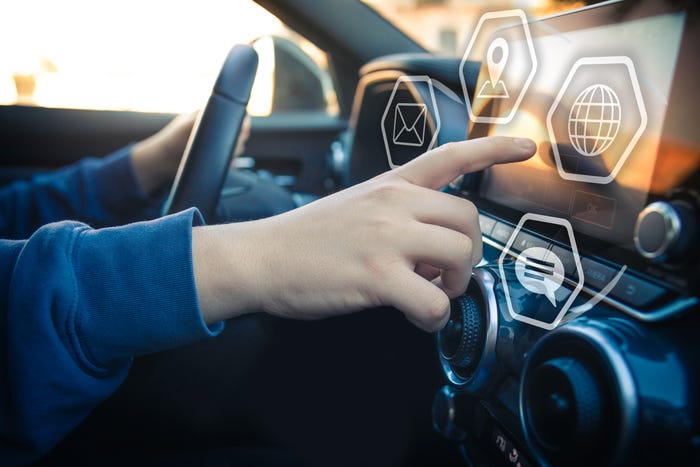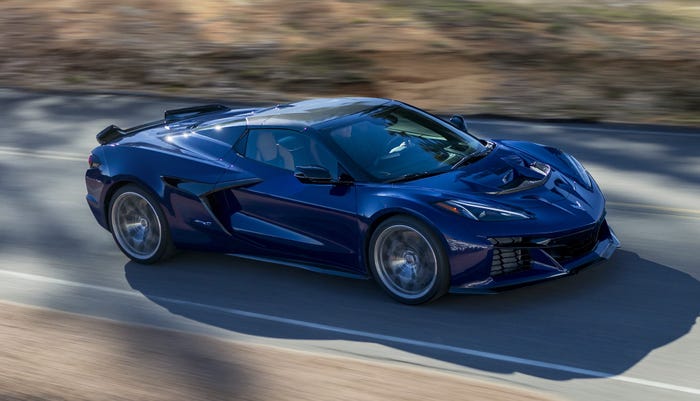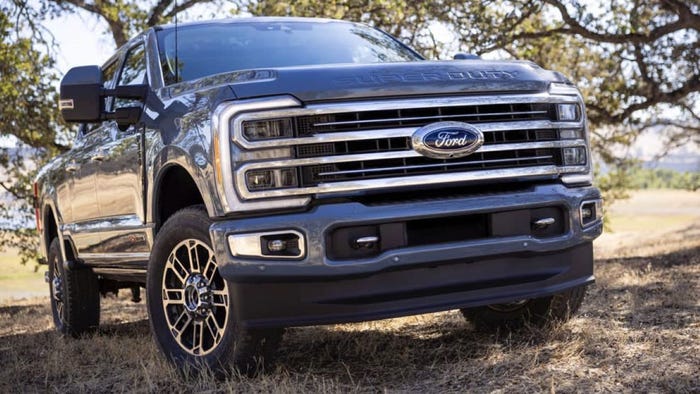Tech Trends and Insights From CES 2024
Software-defined vehicles, or SDVs, were all the rage. Everyone was talking about them: automakers, suppliers, analysts, media – everyone.
.jpg?width=1280&auto=webp&quality=95&format=jpg&disable=upscale)
At a time when most auto shows have withered in grandeur and media relevance, CES has emerged as the most important auto show in the world. No, CES (formerly known as the Consumer Electronics Show), is not an auto show. But the automotive sector at CES gets more support and coverage from automakers, suppliers, analysts and media than any other auto show outside of China.
There are so many press conferences, new-car reveals, tech presentations and supplier announcements that I compared it to drinking out of a fire hose. No, one of my colleagues corrected me, it’s like drinking from the outlet pipes at the Hoover Dam.

CES2024.jpg
I spent a week in Las Vegas at CES and visited with 30 different companies. What follows are some of the notes I scribbled into my notebook. This is not a comprehensive overview of what was announced at CES; it’s just a quick overview of what I saw and heard. And it mostly ignores what the OEMs announced since they already received so much coverage. This is more about the trends and nuggets I learned from suppliers at the show.Software-defined vehicles, or SDVs, were all the rage. Everyone was talking about them: automakers, suppliers, analysts, media – everyone. By my definition, SDV is all about defining and controlling every component and system in a car with software, so it can be improved over time with over-the-air updates (OTA). But writing all that software doesn’t come easily to traditional automakers and suppliers whose expertise lies in the mechanical world.
Traditional automakers are struggling with software because organizationally, they’re doing it all wrong, said Jan Becker, the CEO of Apex.ai. He says you need a small, highly efficient team of only eight to 20 exceptional software engineers (SWEs). And you’d better be ready to pay to get that rock-star talent: at least $1 million a year per engineer, because that’s the going rate for top talent in The Valley. Outsourcing software development to low-cost countries is not the answer, he says, adding that traditional OEMs focus too much on cost and need to focus more on value. Moreover, those SWEs need to operate outside the existing corporate organization. They need short development cycles. They need a single depository of all the data for all the vehicle lines an OEM has, i.e., no more “data lakes” strewn across the company. Also, they need to write in C++ or Rust, but definitely not in C.
ETAS, a subsidiary of Bosch, has software that allows OEMs and their tiers to develop software together. Called DEV OPS, it uploads everything to the cloud at the end of every day and evaluates it to eliminate bugs. This is the way the tech industry does it, ETAS says, developing software in slices. Traditional OEMs, on the other hand, tend to build the entire stack and start testing it. But that’s too slow. And by putting everything in the cloud, you look at a vehicle from a total systems standpoint, not just at individual components or systems.
Even headlamps are getting software-defined. ZKW says it can do “scene-based digital light,” which can reduce or increase the amount of light in specific areas. For example, it can specifically reduce the glaring light that reflects off-road signs and back into a driver’s eyes. Or, by using AR (augmented reality), it can spotlight things a driver may not notice, like pedestrians walking alongside a dark road. In fact, it’s so sophisticated that the headlamps could even project a movie onto a screen or a wall. Monetization suggestions, anyone?
Neural Propulsion Systems claims it has an SDV radar that reduces false positives 10x versus a hardware radar. Better yet, it says overall cost comes down 25%-35%. NPS claims it will announce an OEM contract any day now. It also has military applications that can single out a drone within a swarm of drones.
Developing software is so complicated that intermittent electronic issues can drive development engineers crazy. Intrepid Controls has a wireless development tool that connects to all the electronic components in a car. When an intermittent issue happens, it catches it and sends a text to an engineer with a link to a display that shows exactly where and what the problem was. In one case in Dubai, an intermittent problem was traced to an engineer smoking while testing a car and cracking a window open. That led to an issue with the HVAC system trying to maintain the proper temperature. Catching intermittent issues early is all about solving problems fast and developing new cars faster.
AI, artificial intelligence, was another red-hot topic at CES. Everywhere you went, it was AI this or AI that. AIMMO is a South Korean start-up that uses AI to dive into massive AV (autonomous vehicle) video databases and pull out only the video that’s needed. For example, do you need video of dogs walking along a road? Then just buy that video, not the whole database and then having to hunt around looking for the clips you want. The way AIMMO explains it is, “Why buy a whole smorgasbord of food when all you want is the spaghetti?” It’s partnering with BMW and a soon-to-be-announced U.S. OEM. (Sounds like General Motors or Tesla to me.) AIMMO claims a large OEM can save 30%-40% of the cost of data collection, curation, annotation and evaluation, and save up to 60% if they use AIMMO from the get-go.
At least a half-dozen suppliers are working on driver monitoring systems (DMS) that can detect if a driver is drunk. That’s because the U.S. Congress enacted legislation mandating that intoxication detection technology be in all vehicles starting in 2027. Bosch, for example, has a camera that monitors a driver’s eye movement. Longer fixation (staring) correlates with high levels of alcohol. It also measures what’s called saccade, which is the time lapse between your eyes moving from one point to another. Slower saccade is an indication of drunkenness. (There’s a new word for your automotive vocabulary.) The system checks to see if each eye is open and looks at your mouth to see if you’re yawning, which are other indications of intoxication or drowsiness. The only problem is, at this stage of development it takes about 60 seconds to assess if a driver has had one drink too many. I don’t think the public will tolerate waiting 60 seconds for their car to start while they wait for it to determine whether they’re sober. Clearly, more development work is needed.
Magna uses a camera to detect drunken drivers, too, but it also has a breathalyzer integrated behind the steering wheel. The breathalyzer is fast, cheap ($50-$100 price target), unobtrusive and the driver does not need to blow into a tube. They just have to breathe normally and it measures the alcohol content on their breath automatically. And it won’t be fooled by innocent items that contain alcohol such as mouthwash or beard oil. You read that right, beard oil!
But there’s a problem: If these systems detect that a driver is drunk, no one is sure what to do. Do you disable the car, not let the engine start, or what? What if there’s a raging forest fire and someone who’s been drinking has to flee for their life? Or what if they’re being followed by a stalker in the parking lot outside of a bar and need to get away now? The suppliers who are developing these systems want no part of deciding what to do if the system detects that a driver is drunk. They’re dumping that decision in the laps of the automakers. I’m guessing that automakers are going to want some kind of legal immunity for edge cases like this.
Thermal cameras were a noticeable trend. Gentex is partnering with Israel’s Adasky and Magna showed off its own thermal camera. They’re not just for night vision. They can see right through smoke, fog and just about anything else that can diminish your view ahead of a car. Magna says thermal cameras can see 4x better than humans at night. A year ago I hit a deer that leapt out of the woods at night, and a thermal camera would have alerted me in plenty of time to avoid it. So, I want one now. Thermal cameras already are available on some high-end cars, but it sure would be good to see them spread to every vehicle segment.
There was some talk about hydrogen and fuel cells at the show. But, for me, the biggest news was at Forvia, which showed a rectangular hydrogen tank, literally the size and shape of an EV battery pack. Up to now all hydrogen tanks in cars or trucks have been cylinders, which are difficult to package and take up a lot of space. Forvia’s breakthrough would allow an automaker to remove the battery pack in an EV and bolt a hydrogen fuel tank in its place. Forvia says its rectangular tank can hold more hydrogen than a comparable cylinder.
Clarios is developing sodium-ion batteries for low-voltage applications on cars. They’re lighter than lead-acid, cheaper than lithium-ion, don’t use any conflict materials, offer supply chain independence from China and have longer service life than li-ion. They also offer packaging flexibility compared to bulky lead-acid batteries. Clarios has a partnership with an OEM to put them in cars, but wouldn’t say who.
Speaking of EV batteries, Tal Sholklapper, the CEO of Voltaiq, says getting battery production to scale is as difficult as getting there with microprocessors. In fact, he says battery makers should study how micros went through production hell 30 years ago and learn how they solved it. He says a big problem is that most companies don’t budget enough money to get through the production hell, even though they all go through it. Battery plants only get a 10% yield at launch but need a 90% yield to be profitable. And it typically takes four years and billions of dollars to get there. But after that, a few percentage-points improvement yields hundreds of millions more in profits. He also predicts that lithium-ion will be the dominant EV chemistry for a long time. It’s hit a scale that will not be topped for years to come, and li-on batteries just keep getting better.
Yanfeng showed a concept interior that was intriguing. It pretty much gutted everything in the interior of a car and only put in what is completely necessary. So, no instrument panel. The seats, center console, seat belts and airbags are one unit that bolt into the car. The “steering wheel” is actually a tablet-like screen that sits on the center console between the seats, but can be pulled in front of the driver on a goose-neck stanchion. The driver can turn the tablet just like a steering wheel. The throttle and brake pedals retract into the firewall when parked or in autonomous mode. And the result is an amazing amount of interior room.
Not everything at the show was electronic wizardry, AI or SDV. Schaeffler showed off a stamped-steel beam axle for its e-axle for pickup trucks. It cuts cost and weight, and I gotta tell ya, after all that high-tech stuff at CES, it was a pure joy for me to see an innovation that involved stamped steel and welding!
OK, I’ve saved the craziest ideas for last. Sometimes the best things you learn at a show like CES come from informal side conversations. One idea I heard about sees cars of the future rolling off the assembly line at the same time a digital twin of the car is created. And the two are wirelessly connected. So as the car in the real world gets driven, the digital twin mirrors everything it’s going through. Automakers will use AI to monitor the digital twin and predict when it needs maintenance or repairs, all with the idea of eliminating warranty costs and recalls. That could save automakers billions a year.

McElroy SQUARE_22
The other crazy idea I heard is that SpaceX is coming out with a next-gen satellite that will be in low orbit – so low, in fact, that the latency in communication between car and satellite signals will only be 1.2 nanoseconds. And at that point, all the computing in a car could be moved to the cloud, and all the microprocessors could be removed from the car, taking out a tremendous amount of cost.I ran these ideas past a couple of my technically savvier compadres and they laughed, saying it was impossible to do either. But I heard these crazy ideas from two very intelligent CEOs and so I felt it was worth sharing them with you, because, well, you never know.
John McElroy (pictured, above left) is the president of Blue Sky Productions, which produces “Autoline Daily” and “Autoline After Hours” on www.Autoline.tv and the Autoline Network on YouTube. The podcast “The Industry” is available on most podcast platforms.
About the Author(s)
You May Also Like


_(2).jpg?width=700&auto=webp&quality=80&disable=upscale)


